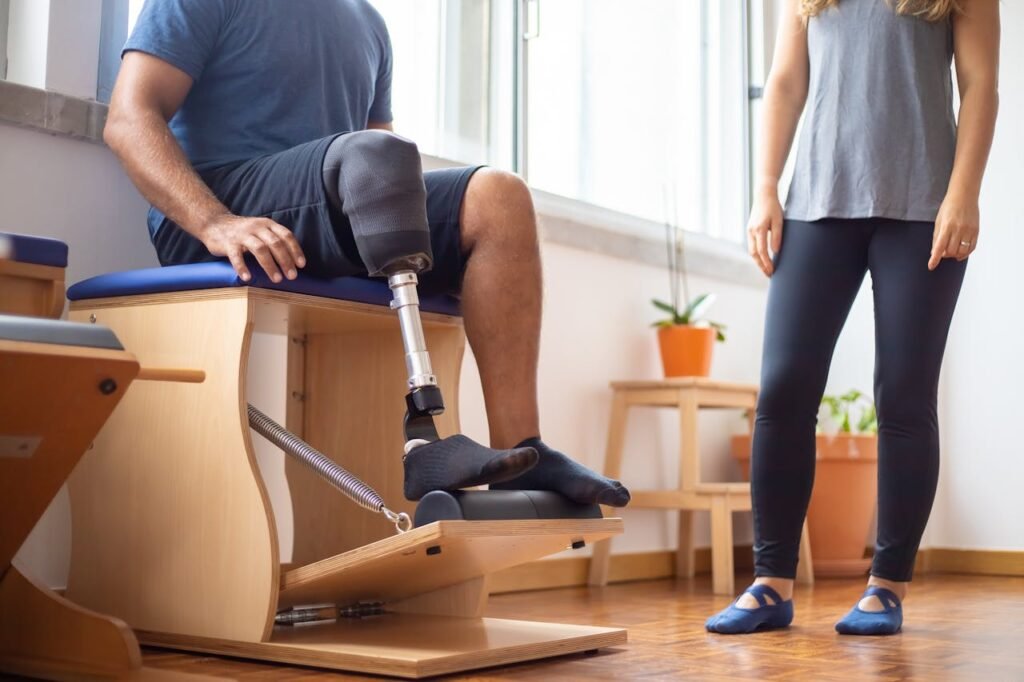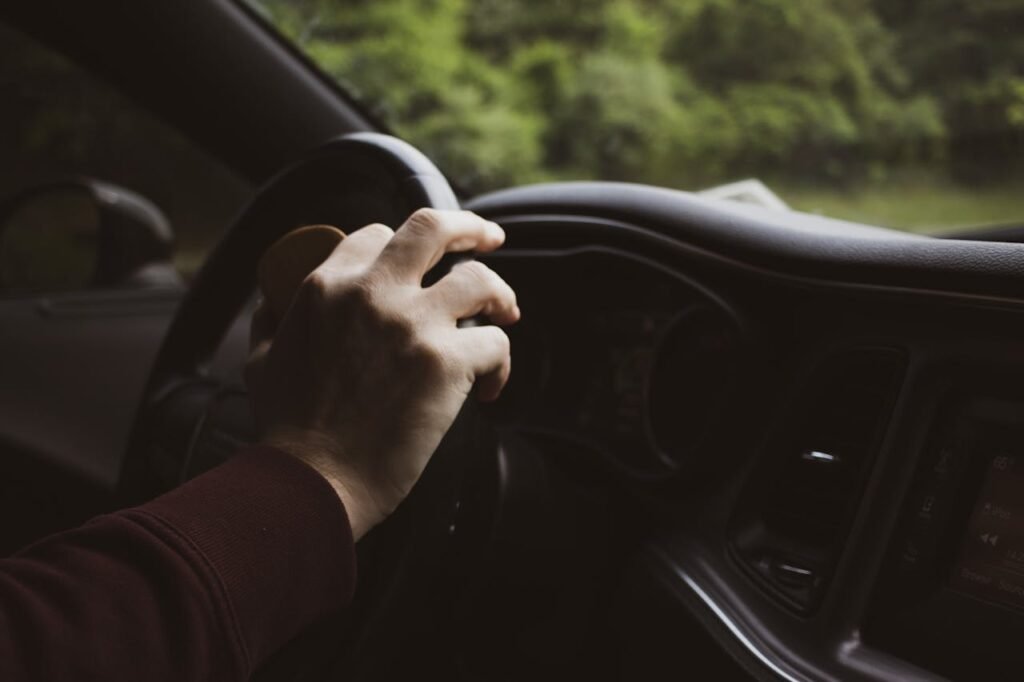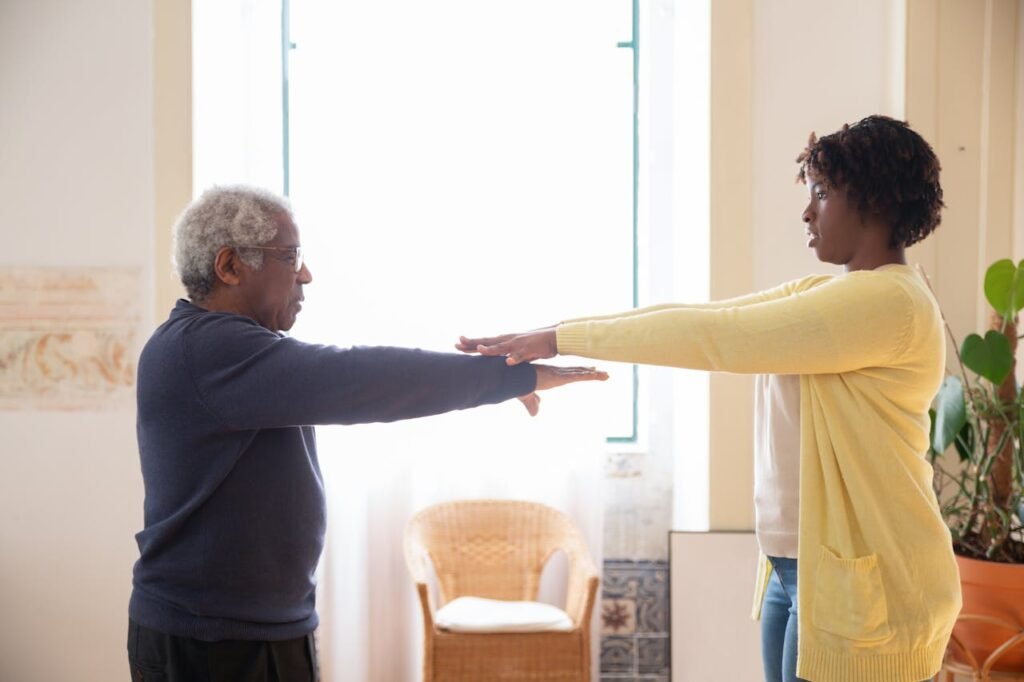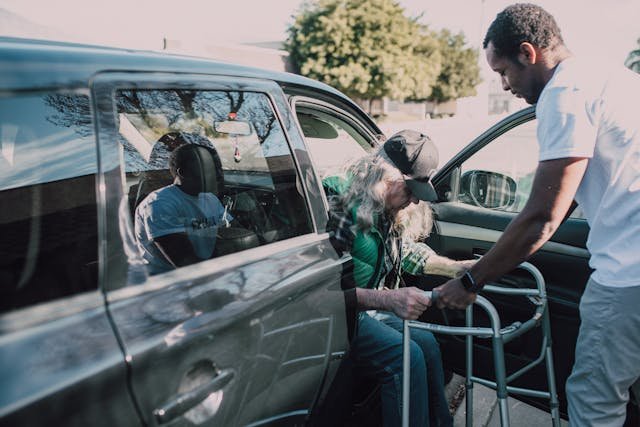Getting in and out of a bed, chair, or car may seem like simple, everyday actions—but for seniors using prosthetic limbs, they can feel challenging at first. These are the moments where balance, confidence, and body control come together. A small movement made the right way can mean safety and independence; the same move done hurriedly or incorrectly can cause strain or even injury.
The good news is that with the right guidance and practice, transfers can become smooth and easy again. You don’t need complex techniques or expensive equipment—just awareness, patience, and a few key steps that make every motion steady and secure.
At RoboBionics, we work closely with seniors across India who use prosthetic hands and legs, and we understand what makes everyday movement feel natural again. Whether it’s getting out of bed in the morning, sitting down for a meal, or stepping into a car, safe transfer techniques restore both freedom and peace of mind.
This guide walks you through those exact techniques—explained simply, step by step. You’ll learn how to make safe transfers from bed to chair, chair to standing, and in and out of cars, with easy adjustments for seniors using prosthetics. Each section blends practical advice with gentle reminders to build confidence over time.
Transferring Safely From Bed: Stability Starts Here
Preparing the Space for a Safe Transfer

A good transfer begins long before the actual movement. The area around the bed should always be clean, bright, and free of clutter. Shoes, bags, or wires near the bed can easily cause a trip or slip.
Place a sturdy chair or walking aid nearby, so your loved one has support ready. The floor should be dry and even. If possible, use a non-slip mat beside the bed for better grip underfoot.
Lighting is important too. A dim room can make it hard for seniors with prosthetics to judge distance or height. Keep a small lamp or nightlight close to the bed for better visibility during early mornings or late nights.
Positioning the Body Before Moving
When waking up, don’t rush to sit up immediately. Let the body adjust for a moment. Start by rolling slowly to one side—the sound limb (the natural leg or arm) should be on the bottom side when turning.
Place the prosthetic limb on the bed in a way that feels natural and within reach. Using the arms, gently push up into a sitting position at the edge of the bed. Keep both feet—or one foot and the prosthetic—flat on the floor for stability.
Seniors using a leg prosthesis may find it easier to put on the prosthetic while sitting at the edge of the bed. This position offers better control and balance.
Sitting Up and Finding Balance
Once seated, take a few seconds to regain balance. The change from lying down to sitting can cause light-headedness, especially in older adults. Encourage slow breathing and small shoulder rolls before standing.
Make sure the residual limb feels comfortable and that the prosthetic socket fits snugly. If it feels loose or tight, readjust it before trying to stand. Comfort and fit are crucial to safe movement.
If the bed is too soft, place a firm board or mattress topper underneath. This gives a better base for pushing up while standing.
Standing Up Safely
When ready to stand, move to the edge of the bed with both feet or the prosthetic and sound limb slightly apart. This wider base gives better balance.
Keep one hand on the bed for support and the other on a nearby chair or walking aid. Lean forward gently from the hips—not the waist—until the nose is directly above the toes. Then, push through the sound leg and stand up slowly.
If balance feels uncertain, pause midway and take a deep breath. The key is not speed but stability. Once standing, adjust posture so that the shoulders are back and the weight is evenly distributed.
Moving From Bed to Chair
For transfers from bed to chair, make sure the chair is positioned close—ideally at a 45-degree angle to the bed. The seat should be stable and, if possible, have armrests for support.
Before standing, check that the prosthetic foot is placed securely and that the path to the chair is clear. Stand up slowly, pivot on the sound leg toward the chair, and reach back to feel the armrest before sitting down.
Avoid turning sharply or twisting the body too quickly. Gentle, deliberate movements prevent strain and protect both the limb and the prosthesis.
Adjusting for Different Bed Heights
Not all beds are the same height, and this matters for safety. A bed that’s too high makes it difficult to plant both feet on the ground, while one that’s too low strains the knees and back.
Ideally, the bed height should allow both feet—or the prosthetic and sound foot—to rest flat on the floor when sitting. If needed, use bed risers or a low step stool to find the right level.
For adjustable hospital-style beds, raise or lower the height slightly before transfers. This makes standing easier and reduces effort on the arms and legs.
Assisting a Senior During Transfer
If you’re a caregiver, stand close but slightly to the side—never directly in front. Keep your knees slightly bent and your back straight to protect yourself from strain.
Offer your arm for support instead of pulling on their hand or prosthetic. Let them do as much of the movement as possible to maintain independence. Guide their motion with gentle words rather than force.
If they feel unstable, help them sit back down and try again after a short rest. Repetition builds confidence and muscle memory over time.
Checking Posture and Comfort After Transfer
Once seated or standing, take a few moments to check comfort. Ask if there’s any pain, pressure, or imbalance. Look for redness or swelling around the residual limb, which may signal the prosthesis was positioned incorrectly.
Encourage small posture corrections—shoulders back, chin up, weight even between both sides. These small habits make movement smoother and safer throughout the day.
When the transfer is complete, ensure the bed and surrounding area are ready for the next time. A neat, well-prepared space keeps future movements stress-free.
Chair Transfers: Building Control and Confidence
Preparing for a Safe Chair Transfer

Chair transfers happen several times a day—moving to eat, read, rest, or watch TV. Since they’re so frequent, it’s important to make them second nature. Start by ensuring the chair is sturdy, has armrests, and does not move when touched or leaned on.
Avoid chairs with wheels or uneven legs. If the floor is slippery, place a rubber mat underneath for grip. The seat height should allow your loved one to sit with both feet—or the prosthetic and sound foot—flat on the ground and knees bent at a right angle.
Good lighting and a clear path to the chair help prevent small accidents. Encourage them to take their time. Safe movement is always better than fast movement.
Moving Toward the Chair
When approaching a chair, it helps to come from a slight angle, rather than straight on. This reduces the need for twisting or turning sharply. Stop just close enough so that the back of the knees lightly touch the chair.
Make sure the prosthetic foot is stable before making any shift in weight. Keep the sound leg slightly behind for better balance. The body should remain upright, with the head facing forward and not downward.
If they use a walking aid, park it to one side and within easy reach once seated.
Sitting Down Smoothly
Before sitting, reach back with one hand to feel for the chair’s armrest or edge. Then reach back with the other hand, keeping the prosthetic knee slightly forward.
Lean forward slightly from the hips, bend the sound knee, and lower slowly. The prosthetic leg should follow naturally without forcing it. The key is control—smooth, slow descent, not dropping suddenly onto the chair.
Once seated, help them adjust until they feel balanced and relaxed. Their weight should be even on both sides, and the prosthetic should be positioned comfortably without strain on the residual limb.
Standing Up from a Chair
Standing from a chair is similar to standing from bed but requires more leg power. Move to the edge of the seat so both feet are firmly on the floor. The prosthetic should be slightly ahead of the sound leg for stability.
Place both hands on the armrests or on the thighs for leverage. Lean forward until the nose is above the toes, then push up slowly. Most of the power comes from the sound leg and the arms, while the prosthetic leg balances the motion.
If balance feels wobbly at first, encourage short breaks. Over time, strength builds and movements feel steadier.
Using Chairs Without Armrests
Some chairs, like dining chairs, don’t have armrests. In these cases, place the hands on the edge of the seat for support. Move forward so the body’s weight is slightly over the feet, then push upward slowly.
For extra safety, caregivers can stand nearby, slightly behind and to the side, ready to assist if balance slips. Never pull the senior forward by their hands or prosthetic—this can cause strain.
Once they’re upright, give them a moment to stabilize before walking or turning.
Managing Low or Soft Chairs
Low or very soft chairs can make standing harder because they require more effort to rise. Whenever possible, use firm cushions to raise the seat height. Avoid deep sofas that sink too low.
If your loved one enjoys sitting in a favorite recliner or sofa, consider adding a small wooden block under the chair legs for extra height. Even a few centimeters can make a big difference.
When standing, encourage them to slide slightly forward to the edge of the seat first. This positions their feet better for lifting power.
Adjusting Transfers for Different Prosthetic Types
Every prosthetic limb has its own movement pattern. Seniors using below-knee prosthetics should focus on even foot placement, while those with above-knee devices must pay more attention to hip control.
For bionic legs with sensors or power assist, remind them to wait for stability signals before shifting full weight. If the prosthesis feels slow or stiff, a small pause ensures smooth coordination.
For those with prosthetic arms or hands, like the RoboBionics Grippy™, it helps to practice safe gripping on chair arms. The grip strength should feel secure but not tight enough to cause wrist tension.
Balance Exercises That Help Chair Transfers
Strong muscles make every transfer easier. Encourage short balance exercises during the day—standing near a wall, shifting weight gently from one foot to another, or holding a stable surface while rising and sitting.
These exercises not only build strength but also improve confidence. They teach the body to trust the prosthesis and restore natural rhythm in movement.
If your loved one feels hesitant, practice with them. Even five minutes of guided movement daily can bring visible improvement within weeks.
Avoiding Common Chair Transfer Mistakes
Many small habits can increase the risk of falls. One common mistake is sitting too fast, which can throw balance off. Another is standing up with the prosthetic foot placed too far back, causing the knee to lock or wobble.
Encourage your loved one to focus on slow, deliberate movement. Rushing or multitasking—like holding an item while sitting—can lead to loss of balance. Always finish one action before starting another.
Over time, these mindful habits become automatic, turning every transfer into a confident, smooth motion.
Giving the Right Kind of Help
If you’re a caregiver, your support can make all the difference. Stand close, offering your arm for stability but not lifting their full weight. Let them do most of the effort. It builds strength and self-belief.
Use calm, encouraging words instead of instructions that sound rushed. A relaxed tone lowers anxiety, helping the senior focus better on movement.
Praise each successful attempt. Even the smallest improvement shows growing control and independence.
Car Transfers: Confidence on the Move
Preparing the Car for Easy Entry

Getting in and out of a car can be one of the trickiest transfers for seniors using prosthetics. The key is preparation. Start by parking the car on level ground with enough space around the door. Avoid slopes or tight spots.
Open the door fully so there’s plenty of room to maneuver. Move the front seat backward and slightly recline it for extra space. If the car sits too low, a small portable cushion or seat riser can make transfers easier.
Keep the area clear of bags or mats that could slip underfoot. If possible, have a non-slip mat near the door to steady their step.
Positioning the Body Before Entry
Approach the car slowly and stop when the back of the knees are just touching the seat edge. The prosthetic foot should be slightly forward, and the sound leg closer to the car. This gives a stronger base for balance.
Using the car door or a stable handle, lean slightly forward and lower yourself carefully into the seat. Avoid twisting or falling back too quickly—lowering the body in one smooth, controlled motion prevents strain.
Once seated, pull both legs inside. For leg prosthesis users, guide the prosthetic leg gently with your hands or a light strap if needed.
Adjusting the Prosthesis for Comfort
After sitting, check that the prosthetic limb is in a comfortable position and not pressing against the seat edge. A poor angle can cause rubbing or swelling during longer rides.
If your loved one wears a myoelectric prosthesis like the Grippy™ hand, ensure that the arm rests naturally by their side or on their lap. Avoid placing pressure on the fingers or wrist joints.
For leg prosthetics, the knee should bend naturally without pulling at the socket. You can place a small cushion or rolled towel under the thigh to ease pressure during long journeys.
Getting Out of the Car Safely
When it’s time to exit, turn the entire body so that both legs are facing the open door. Place the prosthetic foot outside first, followed by the sound leg. Keep hands on the door frame or seat edge for balance.
Lean forward slightly before standing. Push gently with both arms and the sound leg, letting the prosthesis follow naturally. Take a moment to steady balance before stepping away from the car.
If the ground outside is uneven or sloped, hold on to the car door or have a caregiver nearby for added stability.
Helping Seniors with Limited Mobility
For seniors who find car transfers physically tiring, small adjustments help a lot. A swivel seat cushion lets them rotate their body more easily. You can also use a short step stool to reduce the height difference between the car and the ground.
Always check that the stool or step is stable before use. For SUVs or taller vehicles, a side handle (car transfer aid) that attaches to the door latch can give strong support while entering and exiting.
If you’re assisting, stand close and let the senior move at their own pace. Use gentle guidance—never pull their arms or prosthetic limb.
Managing Long Drives
During long trips, encourage short breaks every hour or so. Getting out to stretch prevents stiffness and swelling, especially in the residual limb. Even small ankle or shoulder movements while seated can improve circulation.
Keep water handy, and avoid crossing legs or sitting in the same position for too long. Comfort is key—if the prosthesis starts to feel tight, loosen it slightly and reattach when stepping out for breaks.
Use cushions or seat adjusters to find the right height and posture. A relaxed sitting position reduces fatigue and makes the ride smoother.
Practicing Confidence and Control
Car transfers can feel intimidating at first. The best way to build confidence is through slow, regular practice. Start with stationary drills—sit down, get out, and repeat a few times without the engine running.
Each repetition helps the brain and body remember the sequence: turn, sit, pull in legs, adjust, and rest. Once your loved one feels comfortable, you can try short drives and gradually longer ones.
Encourage them gently, celebrate small progress, and remind them that control comes with time.
Caregiver Tips for Smooth Car Transfers
If you’re assisting, stay calm and patient. Your tone and pace influence how relaxed the senior feels. Stand close enough to guide but give them space to move.
When entering, help by holding the door steady and offering your arm for balance. When exiting, ensure the ground is dry and firm before they take a step.
Carry a small towel or handkerchief to wipe any moisture off the prosthesis or shoe soles—it’s a simple way to prevent slips.
If you’re traveling frequently, make sure the prosthesis is checked regularly by a professional. Over time, even small misalignments can affect comfort during sitting and standing movements.
Emotional Encouragement During Travel
Beyond technique, emotional support plays a huge role. Many seniors hesitate to travel again after limb loss. They may fear falling, slipping, or slowing others down. Reassure them gently that every small step counts.
Talk to them during the process. Say things like, “Take your time, I’ve got you,” or “You did that really well.” Confidence grows when fear is replaced by calm assurance.
Celebrate each success—every safe car transfer is proof that independence is returning, one moment at a time.
Conclusion: Freedom Through Safe Movement

Safe transfers are more than a set of physical actions—they are a bridge to independence. Whether it’s rising from bed, sitting in a chair, or getting into a car, these moments give seniors control over their day and the confidence to live freely.
At RoboBionics, we understand that prosthetics are not just devices—they are extensions of the human spirit. Our mission is to make each movement easier, safer, and more natural for everyone who trusts us with their care.
Prosthetics like our Grippy™ Bionic Hand and advanced lower-limb designs are built for comfort, balance, and confidence. But even the best technology shines brightest when paired with awareness, patience, and consistent practice.
If you or your loved one are learning to move again after limb loss, know that every careful transfer is progress. Every small success is a step toward independence.
And you don’t have to do it alone. Our specialists at RoboBionics can help with personalized prosthetic fittings, movement training, and rehabilitation support—both in person and through tele-rehab.
Book a free demo or consultation today at www.robobionics.in/bookdemo.
Because independence isn’t just about walking again—it’s about living fully, safely, and confidently, one steady step at a time.



